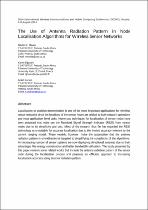 ResearchSpace
ResearchSpace
The use of antenna radiation pattern in node localisation algorithms for wireless sensor networks
JavaScript is disabled for your browser. Some features of this site may not work without it.
- ResearchSpace
- →
- Research Publications/Outputs
- →
- Conference Publications
- →
- View Item
| dc.contributor.author |
Mwila, MK

|
|
| dc.contributor.author |
Djouani, K

|
|
| dc.contributor.author |
Kurien, A

|
|
| dc.date.accessioned | 2015-03-12T09:32:59Z | |
| dc.date.available | 2015-03-12T09:32:59Z | |
| dc.date.issued | 2014-08 | |
| dc.identifier.citation | Mwila, M.K, Djouani, K and Kurien, A. 2014. The use of antenna radiation pattern in node localisation algorithms for wireless sensor networks. In: 2014 International Wireless Communications and Mobile Computing Conference (IWCMC), Nicosia, 4-8 August 2014 | en_US |
| dc.identifier.isbn | 978-1-4799-0959-9 | |
| dc.identifier.uri | http://ieeexplore.ieee.org/stamp/stamp.jsp?tp=&arnumber=6906468 | |
| dc.identifier.uri | http://hdl.handle.net/10204/7888 | |
| dc.description | Due to copyright restrictions, the attached PDF file only contains the abstract of the full text item. For access to the full text item, please consult the publisher's website. | en_US |
| dc.description.abstract | Localisation or position determination is one of the most important applications for wireless sensor networks since the locations of the sensor nodes are critical to both network operations and most application level tasks. Numerous techniques for localisation of sensor nodes have been proposed that make use the Received Signal Strength Indicator (RSSI) from sensor nodes due to its simplicity and cost. Most of the research thus far has regarded the RSSI technology as unsuitable for accurate localisation due to the limited accuracy inherent to the current ranging model. These models, however, make the assumption that the antenna radiation pattern is omnidirectional targeted to simplifying the complexity of the algorithms. An increasing number of sensor systems are now deploying directional antennas due to their advantages like energy conservation and better bandwidth utilisation. The study presented by this paper reviews some related works that include the antenna radiation pattern of the sensor node during the localisation process and proposes an efficient approach to increasing localisation accuracy using antenna radiation pattern. | en_US |
| dc.language.iso | en | en_US |
| dc.publisher | IEEE | en_US |
| dc.relation.ispartofseries | Workflow;14140 | |
| dc.subject | Antenna radiation pattern | en_US |
| dc.subject | Node localisation | en_US |
| dc.subject | Sensor data fusion | en_US |
| dc.subject | Gauss-Newton optimisation | en_US |
| dc.title | The use of antenna radiation pattern in node localisation algorithms for wireless sensor networks | en_US |
| dc.type | Conference Presentation | en_US |
| dc.identifier.apacitation | Mwila, M., Djouani, K., & Kurien, A. (2014). The use of antenna radiation pattern in node localisation algorithms for wireless sensor networks. IEEE. http://hdl.handle.net/10204/7888 | en_ZA |
| dc.identifier.chicagocitation | Mwila, MK, K Djouani, and A Kurien. "The use of antenna radiation pattern in node localisation algorithms for wireless sensor networks." (2014): http://hdl.handle.net/10204/7888 | en_ZA |
| dc.identifier.vancouvercitation | Mwila M, Djouani K, Kurien A, The use of antenna radiation pattern in node localisation algorithms for wireless sensor networks; IEEE; 2014. http://hdl.handle.net/10204/7888 . | en_ZA |
| dc.identifier.ris | TY - Conference Presentation AU - Mwila, MK AU - Djouani, K AU - Kurien, A AB - Localisation or position determination is one of the most important applications for wireless sensor networks since the locations of the sensor nodes are critical to both network operations and most application level tasks. Numerous techniques for localisation of sensor nodes have been proposed that make use the Received Signal Strength Indicator (RSSI) from sensor nodes due to its simplicity and cost. Most of the research thus far has regarded the RSSI technology as unsuitable for accurate localisation due to the limited accuracy inherent to the current ranging model. These models, however, make the assumption that the antenna radiation pattern is omnidirectional targeted to simplifying the complexity of the algorithms. An increasing number of sensor systems are now deploying directional antennas due to their advantages like energy conservation and better bandwidth utilisation. The study presented by this paper reviews some related works that include the antenna radiation pattern of the sensor node during the localisation process and proposes an efficient approach to increasing localisation accuracy using antenna radiation pattern. DA - 2014-08 DB - ResearchSpace DP - CSIR KW - Antenna radiation pattern KW - Node localisation KW - Sensor data fusion KW - Gauss-Newton optimisation LK - https://researchspace.csir.co.za PY - 2014 SM - 978-1-4799-0959-9 T1 - The use of antenna radiation pattern in node localisation algorithms for wireless sensor networks TI - The use of antenna radiation pattern in node localisation algorithms for wireless sensor networks UR - http://hdl.handle.net/10204/7888 ER - | en_ZA |





